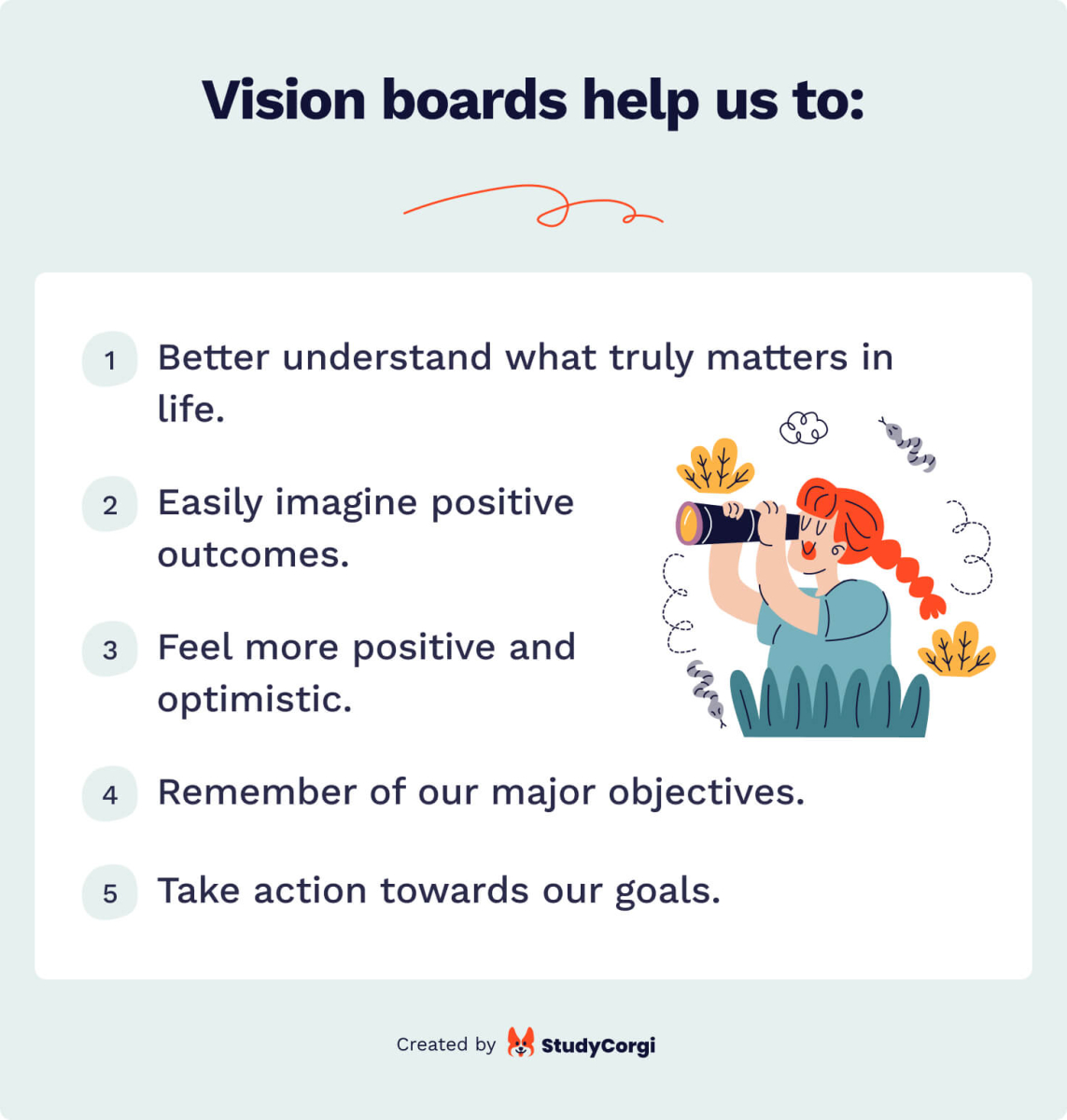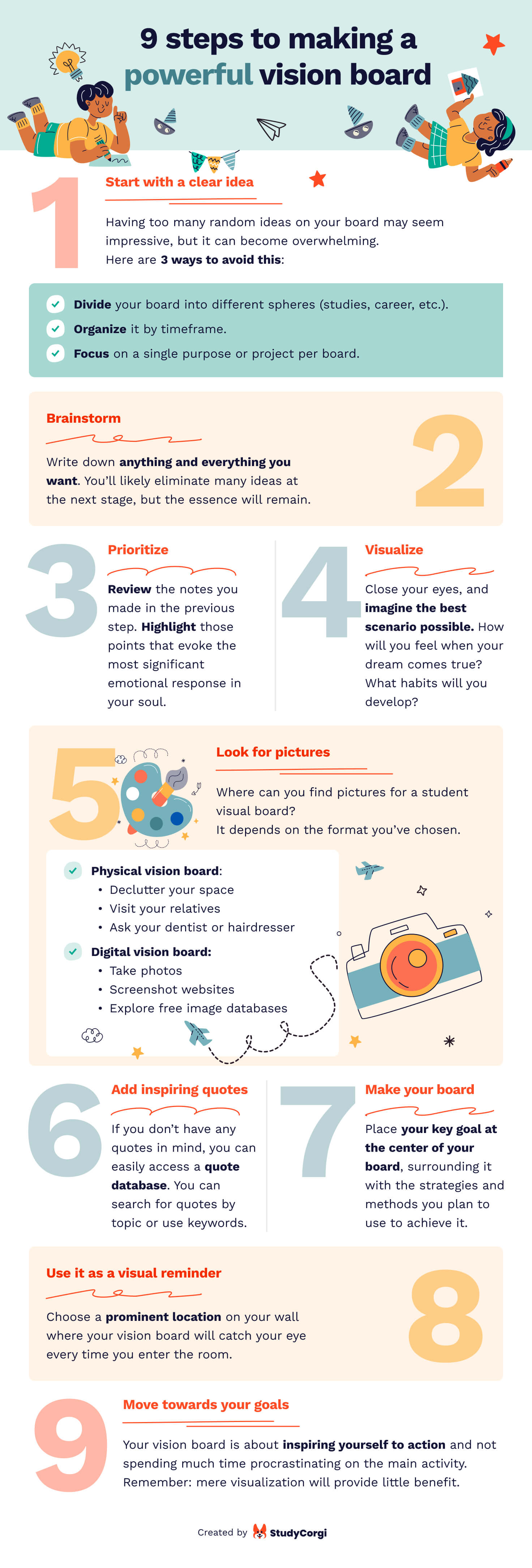A decade or two ago, when you were just a child, sitting on a sandy beach, meticulously building a sandcastle, it often crumbled and didn’t quite follow architectural rules. You found yourself in a constant cycle of refurbishing and fortifying it, and the bigger it grew, the more maintenance it required.
Have you ever wondered why that was the case?
Back then, you didn’t have a clear vision of the desired outcome. Each new tower was added spontaneously, without a predetermined plan in your mind.
This article will delve into the concepts of goal setting and vision boards, offering valuable insights for students. By following our advice, you’ll move away from the spontaneous yet inefficient “sandcastle” approach.
Instead:
You will build a solid foundation of skills required to live your best life.
👀 What Is a Student Vision Board?
What is a vision board for students?
It is a collage of images representing your study goals and general dreams. To create one, you can use pictures cut out from magazines, accompanying them with motivational phrases.
These images and phrases can:
- Describe your lifelong aspirations.
- Envision the near-term future (e.g., a month, semester, or year).

Likewise, vision boards can encompass various aspects of life, including your studies, or focus on a particular discipline or academic challenge.
Here is what you could do to come up with an idea for your student vision board:
- Visualize your dream career.
- Envision your graduation from school or university with honors.
- Imagine the successful completion of a project.
- Create a scenario of your best summer holidays after a successful educational year.
- Visualize your internship abroad.

Student vision boards offer several psychological benefits:
- They help us gain a deeper understanding of what truly matters in life.
- They encourage us to imagine positive outcomes for our future.
- They boost positive emotions and optimism, leading to increased opportunities and a greater likelihood of success.
- They remind us of our major objectives, motivating us to move in the right direction.
- They inspire us to take action and work towards our goals.
In addition to visualizing your plans, vision boards also assist in maintaining a positive focus.
Have you ever noticed that your worst fears sometimes materialize? The mental you hold can become a self-fulfilling prophecy.
However:
Positive expectations are also more likely to come true if you believe in them.
And yes, there is some scientific basis behind these seemingly esoteric concepts.
⚗️ A Bit of Science Behind Student Vision Boards
You may be thinking that you’re too old for student vision boards since this method is often unfairly associated with teenage dreams (which are entirely valid and should be respected). The esoteric background mentioned earlier doesn’t necessarily add to its credibility.
However:
Multiple independent research efforts have confirmed the effectiveness of academic vision boards.
In 2021, the College Teaching Journal published an article by a researcher at Purdue University recommending the use of vision boards in the framework of discussion-oriented courses. The author suggests compiling text, photographs, logos, and clip art into a single PowerPoint slide and presenting it verbally or in writing. This approach allows students to share their backgrounds and goals, fostering a deeper understanding among classmates.
Besides, student vision boards can help instructors identify points of similarity among students, enabling them to tailor discussions more effectively.
While we cannot predict the future, we can certainly chart a preferable direction. This belief is shared by researchers Greg Conderman and Natalie Young, who have highlighted the benefits of vision boards for goal-setting. They argue that students can enhance their academic performance by visualizing their preferred career paths.
The Journal of Creativity in Mental Health published the research results in 2019. The findings suggest that vision boards can be a highly effective tool in career consulting for young professionals. This approach is described as “strength-based and solution-focused,” helping individuals identify and work towards their future goals.
So Why Don’t Academic Visual Boards Always Work?
So why is there so much skepticism about academic visual boards?
The principal condition for success was described back in 1999 when researchers compared two groups of college freshmen:
- The first group visualized a high grade (the desired outcome).
- The second one imagined their preparation (good study habits).
The results of the second group were significantly higher.
The process of visualization led to enhanced planning and reduced anxiety. However, visualizing the end result provided little benefit.
Academic vision boards don’t always work, and the reason is that some of us seek quick results, avoiding the effort of thinking about how to get there.
But there’s a valuable lesson to be learned here:
- Use the vision board as a motivator to take action.
- Include more images that describe the process of goal pursuit.
- Focus on images that represent the ultimate outcome rather than the overall picture.
Read on for more tips on creating and effectively using your academic vision board.
🎯 9 Steps to Making a Powerful Student Vision Board
Creating a powerful vision board involves following certain rules. We hope you’re reading this at the right time, and your collage will serve as a source of inspiration to help you live your best life.
Before we start, remember:
A vision board is your inspiration source, not the goal itself. The most significant benefits will come once you set your sights on achieving the visualized goals.
Step 1: Start with a Clear Idea
Having too many random ideas on your board may seem impressive, but it can become overwhelming. You can create a general visual board for all your goals and purposes.
However:
You’ll soon realize that a general board can appear chaotic, and you might need more detailed boards for each specific topic.
Here are three ways to avoid this:
- Divide your board into different spheres (studies, career, finances, romantic relationships, family, etc.).
- Organize it by timeframe. What do you want to achieve in the short term and long term?
- Some find it effective to focus on a single purpose per board. This approach may seem meticulous and time-consuming, especially if you have multiple wishes, but it brings clarity and improves your understanding of why you want to achieve a particular goal and how you plan to do it.
Step 2: Brainstorm
Now that you have chosen the scope of the student visual board, whether it’s for general life purposes, specific spheres, or periods, it’s time for the most exciting activity – brainstorming!
Remember:
This isn’t the draft version of your vision board yet, so don’t shy away from writing down anything and everything you want. You’ll likely eliminate most of your ideas at the next stage anyway, but the essence will remain.
Here are some questions to ask yourself to make the brainstorming more exciting:
- What do I lack to find happiness?
- Am I living the life I dreamt of five years ago?
- How can I make my average day more enjoyable?
- What skills do I need to be successful in my dream career?
- Which activities make me lose track of time?
- What am I currently good at, and how can I leverage those skills to reach my goals?
Step 3: Prioritize
Once you’ve completed your brain dump, it’s time to review your notes. Cross out the “oh-no” points that don’t inspire or make you sad, and instead, highlight those that evoke the most significant emotional response in your soul.
Ask yourself:
“What do I want to come true more than anything else?”
The answer to this question will be the central theme of your visual board.
You might wonder:
Why you shouldn’t skip steps 2 and 3, given that you already know what to pursue.
You may do so (and we are sure most of our readers will), but the purpose of these steps is to bypass the self-censorship of our consciousness. Often, we convince ourselves that we want something to appear impressive in the eyes of others or to fulfill our parents’ wishes.
The goal is to prioritize what means the most to you, not anyone else.
Step 4: Visualize
Sit back, close your eyes, and imagine the best scenario possible:
- How will you feel when your dream comes true?
- What will you look like?
- Which habits will you develop?
Visualization involves imagining your future goals in a vivid and sensory-rich way. To make it more effective, engage all your senses (sight, smell, taste, touch, and hearing).
This process guides your subconscious toward your desired outcome and trains your brain to respond as if that outcome were already a reality.
Approach visualization as if it were a rehearsal. Just like actors don’t perform perfectly on their first attempt, they “live into” the role and practice until they’re comfortable in their new persona. This helps you understand what it feels like to be the person you aspire to become.
It’s advisable to work through all your most important goals. Consider short meditation sessions followed by note-taking. The resulting notes will be valuable for finding appropriate images and generating inspiring ideas for your vision board.
Step 5: Look for Pictures
Where can you find pictures for a student visual board? It depends on the format you’ve chosen.
Physical Vision Board
If you’re creating a physical board (using paper, fiberboard, or plywood), magazines are an excellent resource for finding images.
Here are some ways to acquire a stack of colorful issues to cut up into pieces:
- Declutter your space. A simple and recommended method is to declutter your living area. Take everything from your shelves and check what brings joy and what doesn’t. This helps you start fresh and often leads to discovering old magazines while clearing out.
- Visit your relatives. Instead of waiting until Christmas to visit your grandparents, consider paying them a visit now. While enjoying tea and cookies, take a look at their coffee table – you might find many old magazines there.
- Ask your dentist or hairdresser. Dentists and hairdressers usually keep magazines in their waiting areas. They are usually willing to part with older issues, even those dating back to the 2010s.
- Post a request on Facebook. Reach out to your friends on Facebook. Some of them may gladly declutter their places and provide you with magazines. Additionally, sharing your plans for a vision board can create a sense of commitment to completing it.
- Buy or subscribe. This is the most expensive option, but still worth considering.
Digital Vision Board
If you’re creating a digital version of your vision board, it can be more convenient, especially for those who are tech-savvy and have limited physical space.
Here are a couple of ideas on where to find images for your digital vision board:
- Take photos. Adding your own photos can make your vision board unique and personal. This option is especially rewarding for people enjoying photography. Capture images of things, people, and experiences that bring you joy. For example, if you dream of working at the local office of a big company, visit the building and take a selfie in front of it. You can use this photo to represent your goal.
- Screenshot websites. We often overlook how many images we encounter daily while browsing the internet. Start saving the relevant pictures for later use.
A piece of advice here is to explore beyond the first image you come across. For example, if your goal is to save enough money to buy a car, look for a car image that aligns with your taste and aspirations.
Step 6: Add Inspiring Quotes
Sometimes, certain ideas or feelings are better conveyed through words. That’s where inspiring quotes come into play.
Find quotes that resonate with your goals and can motivate you to take action.
If you don’t have any quotes in mind, you can easily access a quote database. You can search for quotes by topic, use keywords, or develop your own approach.
Step 7: Create Your Board
Now, it’s time to put your plan into action.
The key principle is to position your ultimate goal at the center of your vision board, with the strategies and methods to achieve it radiating outwards in a spherical fashion.
Creating a goal-setting vision board for students allows for a lot of creative freedom. If you ever find yourself stuck or in need of assistance, you can always use a free vision board maker to help bring your vision to life.
Step 8: Use It as a Visual Reminder
Choose a prominent location on your wall where your vision board will catch your eye every time you enter the room.
Here are some options to consider:
- Above your workspace. Placing it above your working table can have a powerful anti-procrastination effect, helping you stay focused on your goals.
- In front of the entrance door. By positioning it near the entrance door, you won’t be tempted to waste your time on social media when you return home from school.
- In the kitchen. The kitchen is often associated with peace and domestic comfort. It offers a meditative atmosphere where you can contemplate your goals while enjoying your morning coffee.
- Above your bed. Sleep plays a crucial role in brain function and memory. Placing your vision board above your bed can serve as a gentle reminder to stay committed to your aspirations and goals. 9. Move towards Your Goals
Step 9: Move towards Your Goals
Perfect is the enemy of good. Know when to stop editing your vision board. It’s about inspiring yourself to action and not spending much time procrastinating on the main activity.
You already know what to do once it looks nice and has been placed on the wall. Seize the inspiration and use it to your utmost benefit!
🖼 Infographic
We’ve summarized the above tips into a short and sweet picture. Enjoy!

Thank you for reading!
Dreams bring meaning to our lives only as long as they lead us to the right activities. We hope that this article helped you connect with your inner self and define your goals. We would be delighted to hear your success story in the comments below.
